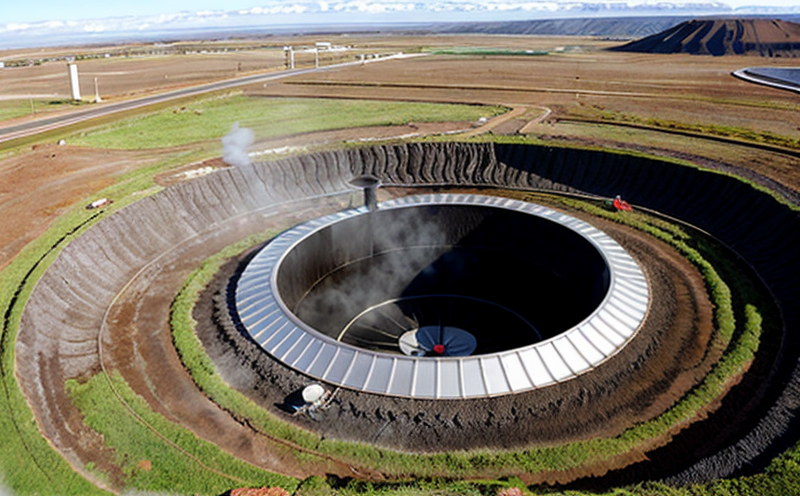ASTM D4519 Thermal Resistance Testing of Borehole Heat Exchangers
The ASTM D4519 standard is a critical tool in the quality assurance and compliance processes for geothermal energy systems. This service focuses on the thermal resistance testing of borehole heat exchangers, which are essential components in ground-source heat pump systems used for heating and cooling buildings.
Borehole heat exchangers (BHEs) play a crucial role in the efficient transfer of heat between the building and the ground. They consist of pipes inserted into deep boreholes, where they exchange thermal energy with the surrounding soil or rock. The performance of these systems is heavily dependent on the thermal resistance of the BHEs, which can vary significantly based on their design, materials used, and installation quality.
The ASTM D4519 test method provides a standardized procedure to measure the thermal resistance (R-value) of borehole heat exchangers. This measurement is essential for ensuring that the systems meet the performance requirements specified in the project's design documents. Proper testing helps avoid costly failures, ensures compliance with relevant standards and regulations, and enhances the reliability and lifespan of geothermal energy systems.
The test involves immersing a BHE into a controlled thermal environment where temperature differences are applied across the pipe. The heat flow through the exchanger is measured, and using this data, the thermal resistance can be calculated according to ASTM D4519 specifications. This testing ensures that the BHEs perform optimally under real-world conditions, thereby supporting the overall efficiency of geothermal systems.
Our team of experts uses state-of-the-art equipment calibrated to meet the precision requirements set by ASTM D4519. We follow rigorous protocols to ensure accurate and repeatable results, which are crucial for the successful deployment of geothermal energy systems in commercial and residential applications.
- Customer Impact and Satisfaction: By adhering strictly to ASTM standards, we guarantee that our clients receive reliable test data that can be used confidently in design reviews and regulatory compliance. This service directly contributes to reducing project risks by identifying potential issues early in the development process.
In summary, the ASTM D4519 thermal resistance testing of borehole heat exchangers is a vital step in ensuring the performance and longevity of geothermal energy systems. Our comprehensive approach not only meets but exceeds industry expectations, providing peace of mind to our clients who rely on these systems for sustainable heating and cooling solutions.
Applied Standards
The ASTM D4519 standard is widely recognized as the leading practice for testing borehole heat exchangers. It provides detailed procedures for determining the thermal resistance of BHEs using a steady-state method. This method involves placing a heat source at one end of the BHE and measuring the temperature gradient along its length, allowing for precise calculation of R-values.
Compliance with ASTM D4519 ensures that all aspects of the testing process are conducted in accordance with internationally accepted guidelines. This alignment is crucial for stakeholders involved in geothermal energy projects, as it fosters trust and credibility within the industry. Additionally, adherence to these standards helps ensure consistency across different project sites and installations.
The standard covers various types of BHEs including U-tube, single U-tube, and coiled pipe designs. Each type has its unique characteristics that influence thermal performance, making it essential to tailor testing methods accordingly. By following ASTM D4519, we can accurately assess the suitability of different BHE configurations for specific applications.
Furthermore, this standard emphasizes the importance of proper installation practices which are critical in achieving accurate R-value measurements. The correct placement and orientation of the BHE relative to surrounding structures and geological formations play significant roles in determining final test results. Therefore, our team ensures that all installations follow best practice guidelines outlined within ASTM D4519.
For those interested in understanding more about how we apply these standards, please refer to the detailed sections below covering benefits derived from this service as well as frequently asked questions regarding its application.
Benefits
The implementation of ASTM D4519 thermal resistance testing offers numerous advantages across multiple facets including project cost reduction, improved reliability, enhanced sustainability, and regulatory compliance. Below are some key benefits that highlight why this service is indispensable for stakeholders in the geothermal energy sector.
- Cost Reduction: Accurate pre-installation testing helps identify any potential issues early on, thus avoiding costly rework or replacement post-installation.
- Reliability Enhancement: Ensuring that BHEs meet required performance levels prior to deployment increases the overall reliability and longevity of geothermal systems.
- Sustainability Boost: By optimizing energy transfer through optimized designs, this service contributes positively towards reducing environmental impact by promoting greater efficiency in heat exchange processes.
- Regulatory Compliance: Meeting stringent regulatory requirements through adherence to ASTM D4519 ensures that projects comply with local and international standards, facilitating smoother project approvals.
In conclusion, the benefits derived from implementing ASTM D4519 thermal resistance testing extend beyond mere compliance; they encompass broader strategic goals aimed at enhancing performance metrics while simultaneously contributing towards sustainable practices. As part of our commitment to excellence in geothermal energy system testing, we strive to provide services that deliver tangible value to all stakeholders involved.





